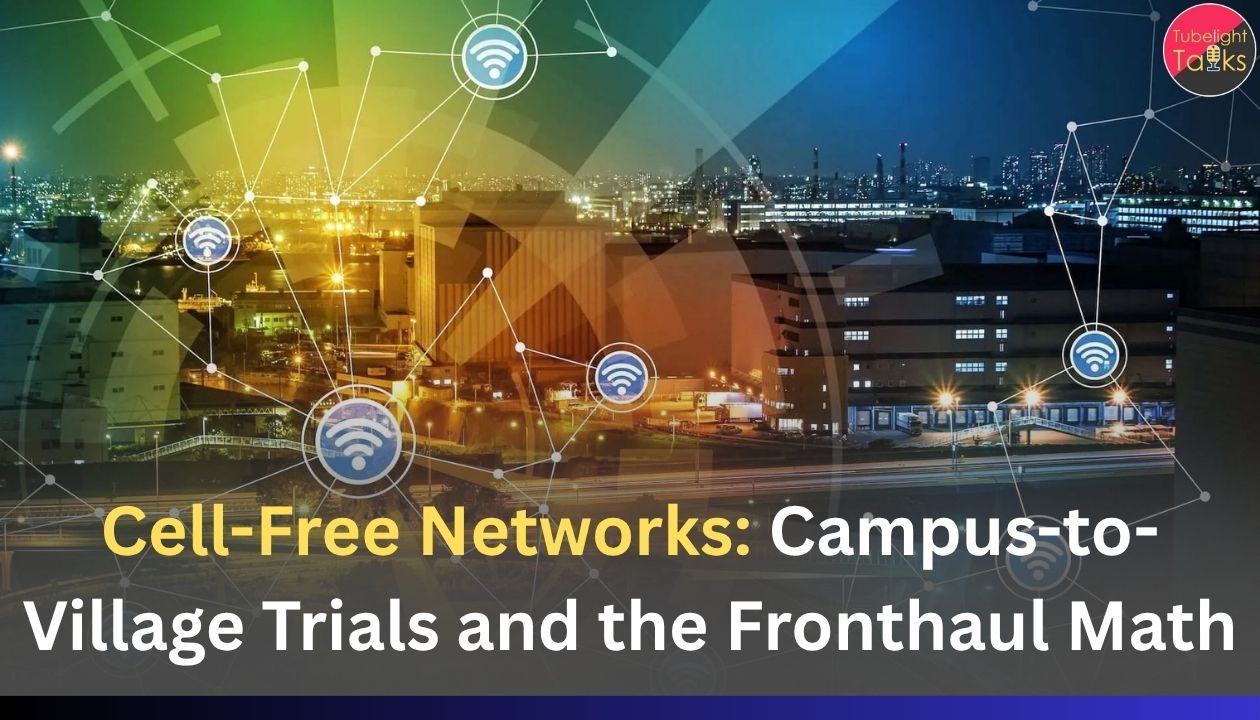Cell-free Networks massive MIMO is one of the boldest ideas in 6G: instead of a few tall towers with hard cell edges, you scatter many small access points (APs) and make them cooperate as one giant, distributed antenna array. There are no cells; every user is served by a loose cluster of nearby antennas.
On paper, the benefits are huge: near-uniform coverage, better indoor performance, and the ability to push high-capacity 6G down into dense campuses and far-flung villages. In practice, early campus testbeds and rural “last-mile” simulations are hitting a common wall: fronthaul capacity and latency—the pipes that connect those many APs back to a central brain.
This is the story of how cell-free networks are being trialled from universities to villages—and why the “fronthaul math” is now the real bottleneck.
What “cell-free” actually means
In a cell-free massive MIMO (CF-mMIMO) network:
- Dozens or hundreds of distributed APs (each with a few antennas) are spread over an area.
- All APs are connected by fronthaul (fiber, microwave, or satellite) to one or more central processing units (CPUs).
- In a given time–frequency slot, many APs jointly serve each user with coherent beamforming—there are no fixed cell boundaries.
This is different from:
- Traditional cells – one base station owns a patch of geography.
- Distributed MIMO inside one cell – antennas are scattered, but still serve only that cell’s users.
Cell-free tries to make the entire area behave like one “super-cell”, smoothing out coverage holes and interference.
Campus-to-village: How trials are starting to look
1. Campus testbeds: O-RAN + cell-free + AI
A recent 2025 testbed shows the “campus” end of the story. Researchers built an O-RAN-based cell-free MIMO network with multiple distributed APs and a full 5G standalone core, controlled by a RAN Intelligent Controller (RIC) running AI-powered xApps.
Key points from this prototype:
- It uses open-source 5G RAN software and an O-RAN architecture.
- Multiple APs cooperate to serve commercial off-the-shelf 5G phones on a university-style campus.
- An AI xApp dynamically associates users with the best subset of antennas, boosting throughput for interference-prone users.
This is a private 5G / 6G-path testbed: think smart campuses, factories, or hospitals where you control the fiber, ceiling APs, and IT team. Fronthaul is still a concern, but you can often pull short-reach fiber between buildings.
2. Village scenarios: satellite fronthaul and 1000 km gaps
At the other end is the village. A 2024 feasibility study examined a cell-free massive MIMO system with satellite backhaul over high-frequency bands. It modelled:
- An 800 m × 800 m rural area covered by distributed APs,
- Located about 1,000 km away from the nearest fibre point of presence (PoP),
- With a hybrid RAN architecture where a satellite link provides fronthaul/backhaul, and local wireless links handle the last mile.
Simulations in that work explored:
- How many APs you actually need for good throughput in the village cluster,
- How satellite fronthaul capacity and latency limit the benefits of going “full” cell-free,
- Trade-offs between centralised processing (great performance, huge fronthaul) and more local processing (less fronthaul, more complexity at the edge).
This is the rural connectivity dream: instead of one tall macro tower serving a giant, spotty cell, you sprinkle cheaper APs around a village and use satellite/long-haul fiber to connect them to the core. The catch is that every AP now talks to the central CPU—constantly.
3. Policy and white-paper vision: from urban streets to remote farms
Beyond individual projects, 6G white papers and surveys now treat cell-free massive MIMO as a core building block for:
- Urban microcells: outdoor APs serving mixed indoor/outdoor users in dense cities.
- Campus / enterprise networks: factories, ports, university campuses.
- Rural & remote areas: hybrid macro + cell-free layers, sometimes with aerial APs or satellite fronthaul.
Conceptually, you want one continuous “fabric” of connectivity—from lecture halls to farms—backed by clever RAN splits, optical fronthaul, and sometimes GEO/LEO satellites.
But every extra AP and every extra antenna pushes up one line item: fronthaul traffic.
The fronthaul math: why cell-free is so bandwidth-hungry
In a cell-free network, each AP must exchange with a central (or regional) unit:
- IQ samples or pre-processed baseband data,
- Channel state information (CSI),
- Control messages for scheduling and power/beamforming decisions.
If you choose a very centralised split (ship most baseband to the cloud), the required fronthaul capacity roughly scales with:
Fronthaul rate ∝ Bandwidth × Antennas per AP × Number of APs × Quantisation bits
For wideband 5G/6G (e.g., 100 MHz channels) and multi-antenna APs, this quickly runs into multi-Gbps per AP, before overheads. When you multiply that by dozens or hundreds of APs, you get tens or even hundreds of Gbps per cluster.
Researchers are seeing the impact directly:
- Analyses of fronthaul-limited CF-mMIMO show that performance gains saturate if you keep adding APs but don’t also scale fronthaul—and that smart compression, functional splits, or user-centric clustering are mandatory, not optional.
- Studies on cell-free in O-RAN highlight the need to jointly optimise radio, optical fronthaul, and cloud resources to avoid blowing up power and cost.
In simple terms: the more “cell-free” you try to be, the fatter and smarter your fronthaul must become.
Design tricks: bending the fronthaul curve
To make cell-free feasible from campus to village, current research leans heavily on a few ideas.
1. User-centric clustering & hierarchical cell-free
Instead of every AP serving everyone:
- User-centric clustering assigns each user to a small dynamic subset of nearby APs, cutting the number of AP–user links that need full CSI and data over fronthaul.
- Hierarchical cell-free architectures propose fewer full APs and more lightweight radio heads, shrinking the size and load of the fronthaul domain.
You sacrifice a bit of theoretical “everyone-serves-everyone” purity, but gain scalability.
2. Local/partial combining at the edge
A popular approach is local or partial combining: APs or small clusters pre-combine some signals locally and send only compressed or aggregated streams up the fronthaul.
- Experiments with local-partial combining schemes show you can cut fronthaul load substantially while retaining much of the cell-free performance, especially in uplink.
- AI-based compression and quantisation (deep learning for fronthaul mapping) can further boost throughput at the same link rate.
In a campus, this might mean a building-level edge node; in a village, a “cluster controller” in the panchayat office aggregating a few nearby APs.
3. Smarter transport: optical, wireless and satellite mixes
Cell-free networks are forcing transport engineers to rethink fronthaul:
- 6G optical fronthaul surveys emphasise new fibre topologies, wavelength-division multiplexing and low-latency routing tuned specifically for massive MIMO and cell-free scenarios.
- Hybrid fibre–wireless–satellite models, like the rural cell-free study with satellite backhaul, explore how to deliver enough capacity to remote clusters without pulling fibre 1000 km.
- Integration with O-RAN means you can place some intelligence in regional DCs, some at edge clouds, and some in the RIC—matching fronthaul capacity to where the most critical decisions are made.
The endgame is a transport network that is co-designed with the RAN, not an afterthought.
Why this matters for “campus-to-village” connectivity
If cell-free works, you can imagine:
- Campuses and factories with seamless indoor–outdoor coverage and deterministic performance for AR/VR, robotics and private 5G/6G.
- Villages and small towns where a modest cluster of APs, maybe aided by satellite, provides reliable broadband without waiting years for fiber trenches.
But if the fronthaul challenge is ignored, you risk building fragile, costly networks that only work in a few rich campuses and never reach the gram panchayat.
The current wave of trials is essentially a live question:
Can we architect cell-free networks so that they scale down to a village as gracefully as they scale up to a research campus?
“Cell-free” beyond radio—removing digital boundaries
From a Satgyan lens, as taught by Sant Rampal Ji Maharaj, the core issue is not just how cleverly we route bits—but why and for whom we build these networks.
Some spiritual reflections that echo through this technology debate:
Removing “cells” vs removing inequality
- Technically, cell-free removes hard radio boundaries.
- Socially, true progress means removing barriers between urban and rural, rich and poor, connected and unconnected. A 6G campus with 10 Gbps while nearby villages lack basic connectivity reflects adharma in priorities, not in physics.
- When public funds, spectrum and satellite slots are used, justice demands that benefits reach remote schools, clinics and farmers—not only data centres and corporate HQs.
- Cell-free designs that explicitly target rural fronthaul limits and affordability are closer to this spirit of nyay than those focused only on stadiums and malls.
- Networks that support telemedicine, education, disaster alerts and rural livelihoods become instruments of seva—selfless service.
- A “campus-to-village” vision of cell-free networks resonates with Satgyan when the goal is sarva-hit (welfare of all), not just premium experiences for a few.
FAQs: How Cell- free Networks Help Villages?
1. What is a cell-free network in simple terms?
A cell-free network uses many small access points working together as one system, giving users stronger, fairer coverage instead of fixed cellular zones.
2. Are there real cell-free trials today?
Yes. Several campus testbeds, rural feasibility studies, and 6G projects are already testing cell-free MIMO with distributed APs and advanced fronthaul.
3. Why is fronthaul a big issue?
Because each AP must send heavy baseband and channel data to central processors, creating multi-Gbps traffic that demands high capacity and low latency.
4. How do engineers reduce fronthaul load?
By using user-centric clusters, local signal combining, hierarchical designs, and hybrid fibre-wireless-satellite fronthaul to cut data traffic.
5. When will cell-free networks become commercial?
Likely in the late 2020s to early 2030s, starting with campus pilots, rural trials, and hybrid 5G/6G deployments.










